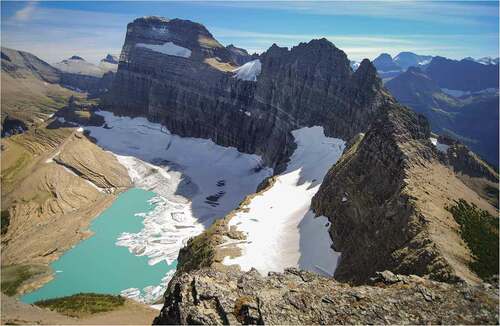Looking south from Grinnell Mountain to Upper Grinnell Lake, Glacier National Park, Montana. Photo credit: Dan Fagre, USGS

The photo captures many attributes of this alpine landscape that have been the subject of research for several decades. Recent research products include an article in the current Volume 52 on alpine plant community diversity by George Malanson et al. (2020) and a Volume 51 article on glacier recession since the Little Ice Age by Chelsea Martin-Mikle and Daniel Fagre (2019).
Glacier National Park has long been a valuable research site for understanding the complexities of mountain ecosystems and their responses to climate change. Its relatively large size of over 4,000 km2, early establishment as a national park in 1910, isolation from urban areas, and a buffer zone of natural landscapes, e.g., national forests, make Glacier National Park a protected and relatively pristine ecosystem that can act as a baseline for assessment of climate change impacts.
References
- Malanson, G. P., E. L. Nelson, D. L. Zimmerman, and D. B. Fagre. 2020. Alpine plant community diversity in species–area relations at fine scale. Arctic, Antarctic, and Alpine Research 52 (1):41–46. doi:https://doi.org/10.1080/15230430.2019.1698894.
- Martin-Mikle, C. J., and D. B. Fagre. 2019. Glacier recession since the Little Ice Age: Implications for water storage in a Rocky Mountain landscape. Arctic, Antarctic, and Alpine Research 51 (1):280–89. doi:https://doi.org/10.1080/15230430.2019.1634443.
